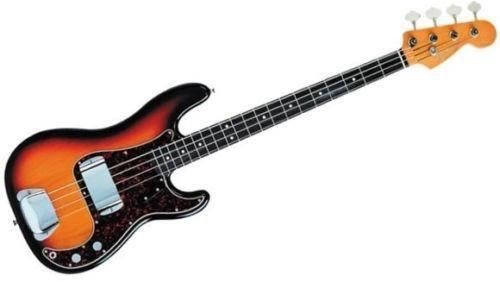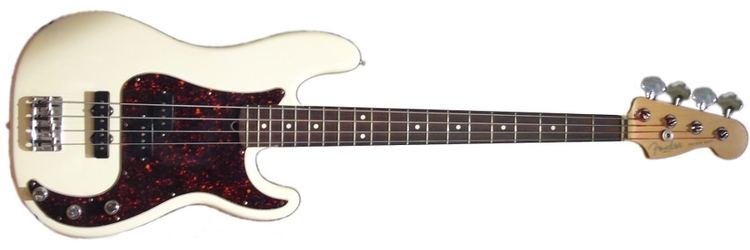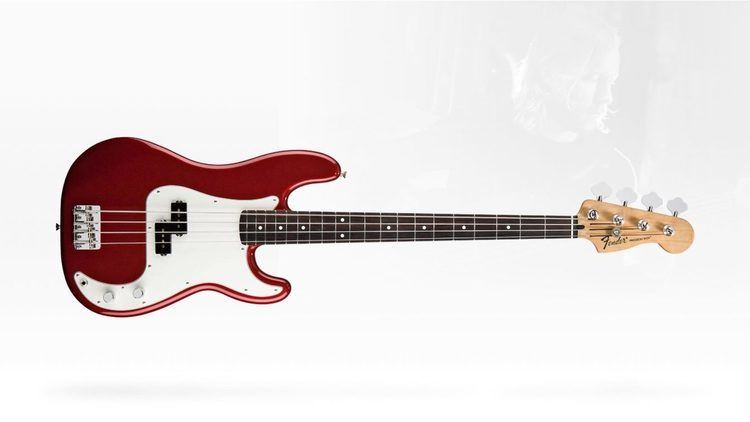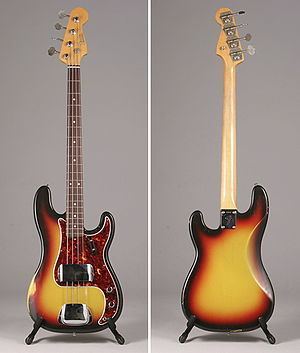Period 1951–present Bridge Fixed Invented 1950 | Body type Solid Body AlderAshPoplar Instrument family Guitar Fretboard Maple Bodies Alder, Ash, Cottonwood | |
 | ||
Pickup(s) One single-coil (1951–1957)Usually one two-piece split-coil humbucker (1957–present)One split-coil humbucker and one Jazz Bass single-coil ("PJ" configuration)One split-coil humbucker and one humbucking Jazz Bass pickup (1995-2009) Manufacturer Fender Musical Instruments Corporation | ||
Norman s rare guitars guitar of the day 1963 fender precision bass sunburst
The Precision Bass (often shortened to "P-Bass") is a bass guitar manufactured by Fender Musical Instruments Corporation. In its stock configuration the Precision Bass is a solid body, four-stringed instrument equipped with a single split-coil humbucking pickup and a one-piece, 20 fret maple neck with rosewood or maple fingerboard.
Contents
- Norman s rare guitars guitar of the day 1963 fender precision bass sunburst
- History of the fender precision bass cme vintage bass guitar demo
- Background
- Design alterations and variants
- Literature
- References

Its prototype, designed by Leo Fender in 1950, was brought to market in 1951, the first electric bass to earn widespread attention and use, remaining among the best-selling and most-imitated electric basses with considerable effect on the sound of popular music ever since.

The Standard P-Bass is sanded, painted and assembled in Ensenada, Baja California, Mexico along with the other Standard Series guitars. Fender also produces Precision and Precision/Jazz basses in its Squier line of products.

History of the fender precision bass cme vintage bass guitar demo
Background

The double bass is physically cumbersome and difficult to transport. It was also becoming hard to hear in large bands or those that used amplified instruments and it requires skill to play such that it can not be readily picked up by any guitarist.

The Precision Bass overcame these problems. The name "Precision" came from the use of frets to play in tune more easily than upon the fretless fingerboard of the double bass. The electric bass lacks the distinctive acoustic qualities of the double bass, offering a more solid, harder-edged sound with more sustain. The bass guitar became more dominant and transformed the beat and rhythm of pop music from jump blues and swing to rhythm and blues, rock, soul and funk.

Acceptance of the electric bass was helped by the endorsement of Elvis Presley's bass-player Bill Black. Black was beginning to use a Precision Bass during the filming of Jailhouse Rock. Fender also delivered an early Precision to LA session bassist and arranger Shifty Henry. Monk Montgomery became the first jazz player to popularize the "Fender Bass" while playing with his brother, guitarist Wes Montgomery.
Design alterations and variants

The original Precision Bass of 1951 shared several of its design features with the six-string Telecaster guitar, the main difference being its double cutaway body. In 1954 the Precision Bass received contoured edges for comfort while otherwise retaining the existing Telecaster-like styling.
In 1957 the headstock and pickguard were redesigned to resemble Fender's recently introduced Stratocaster guitar, a rounder neck heel replacing the original square shape. A redesigned pickguard was made of a single layer of gold-anodized aluminum with 10 screwholes. At the same time the original single-coil pickup was replaced by the Precision split-coil design with staggered polepieces, connected in a humbucking mode; however, Fender never emphasized this, as the Seth Lover patent on the humbucking pickup had not yet expired.
In 1959 a glued-on rosewood fingerboard featuring "clay"-style dot position markers replaced the 1-piece maple neck and remained standard until 1966/67, when the CBS-owned Fender companies began to offer a separate, laminated maple fingerboard capped on a maple neck. Rosewood fingerboards were then made of a veneered, round-laminated piece of wood and pearloid dot markers replaced the "clay"-style inlays introduced in 1959.
In 1960 the aluminum pickguard was replaced with a 13-screw celluloid design having 3 or 4 layers of black, white, mint green, aged white pearloid or brown "tortoise-shell"). In that same year the newly designed Fender Jazz Bass was released.
The original Telecaster-derived design, with a few updates, was reintroduced in 1968 as the Telecaster Bass. Within a few years, however, it had evolved into a model distinctly different from the contemporary Precision Bass, alongside which it was marketed through 1979. Two artist-designed models use the Telecaster Bass body style; the Mike Dirnt Precision Bass, using today's standard single split-coil pick-up, and the Sting Precision Bass, using a single coil pick-up as did the earliest design.
Since 1969 the 1-piece maple neck option has been fitted to many Fender basses and the rosewood fretboard offered as alternative. Some Precision Basses made in the 1970s were also available with an unlined fretless rosewood, ebony or (usually) maple fingerboard, popularized by endorsees Sting and Tony Franklin. Fender briefly offered a fretless P Bass in the mid-1990s as a part of the first-generation American Standard line but dropped this variant at the end of the 20th century.
From 1980 to 1984 the Precision Bass was given new active pickups and a high-mass brass bridge. The Special (1980) featured a split-coil pickup with white covers, gold hardware, a 2-band EQ and an active/passive toggle switch. The Elite (1983) had one (Elite I) or two (Elite II) split-coil humbucking pickups, TBX tone circuit and a Schaller fine-tune bridge later used on the Plus Series models of the early 1990s. Some models were available with solid walnut body and stained ebony fretboard. Japanese models appeared in late 1984, with a smaller body shape and a modern C-shape maple neck with 22 medium-jumbo frets.
The 1990s saw the introduction of the Precision Plus and Deluxe Plus basses in 1989 and 1991, featuring Lace Sensor pickups, fine-tuner bridges, 22-fret necks and passive or active electronics on certain models. The Custom Shop 40th Anniversary model of 1991 was a luxurious version of the Precision Plus Deluxe bass with gold hardware, a quilted maple top and an ebony fretboard with side dot position markers.
The American Series Precision Bass was introduced in 2000 and discontinued in 2008. From 2003 the S-1 switching system allowed the pickup coils to be switched from series to parallel,offering a wider tonal range, but this was discontinued in 2008 with the second generation of American Standard Series instruments.
The American Standard (featuring a high-mass vintage bridge and Hipshot lightweight staggered tuning machines), American Deluxe (featuring a J-style humbucking pickup in the bridge position and an active 3-band EQ with an 18V power supply), Highway One (featuring '70s styling, BadAss II bridges with grooved saddles and a Greasebucket tone circuit since 2006) and American Vintage series models are manufactured in Corona, California.
As of December 5, 2008 the Standard P-Bass has been updated with CBS era-style decals, a 3-ply parchment pickguard and a tinted maple neck with rosewood or maple fingerboard. Other features include a split-coil hum-cancelling pickup and a return to the knurled chrome flat-top control knobs. Models produced before 2003 came for a period with aged white Stratocaster control knobs.
As of March 23, 2010 all American Deluxe Precision Basses came with a N3 stacked-coil Jazz Bass pickup in the bridge position, a 21-fret tinted maple neck with compound rosewood or maple fingerboard with white or black pearloid dot markers, an active/passive toggle switch, a high-mass vintage bridge, Hipshot lightweight vintage tuners, a stealth retainer bar for the A string and a bold CBS-era headstock decal. As of March 23, 2012 the American Standard Precision Bass (except the 5-string version) comes with a Custom Shop 60's P-Bass split-coil humbucking pickup. The 2012 color chart listed 3-Color Sunburst, Olympic White, Black, Candy Cola, Jade Pearl Metallic, Charcoal Frost Metallic as available finishes during that period. As of April 19, 2012 the American Standard Precision Basses are loaded with the Custom Shop '60s Precision Bass split single-coil pick-ups, a 20-fret graphite-reinforced maple neck with compound rosewood or maple fingerboard with white or black pearloid dot markers and a high-mass vintage bridge. It be bought as a 4 or 5 string bass. American Deluxe "Ash Body" Precisions were offered from 1995 to 2006, and are currently available as of 2011; the 2004 color chart listed Aged Cherry Sunburst, Butterscotch Blonde and Tobacco Sunburst as available finishes during that period.
The Road Worn Series 50s P-Bass (introduced in 2009) features a distressed alder body with nitrocellulose lacquer finish, a 1-ply gold anodized pickguard, a synthetic bone nut, American Vintage hardware, a split-coil humbucking pickup and a 1-piece maple neck/fingerboard with 20 vintage frets.
Fender has also produced several 'Deluxe' or 'Special' models that feature active electronics and/or a Jazz Bass pickup or humbucking soap-bar-type pick-up at the bridge position as well as the normal split-coil pickup to increase the tonal options available. Some P-Basses with J-style bridge pickups used the Jazz Bass control layout—2 volumes and tone—and a side-mount jack socket. Others had the front pickup volume control moved forward to leave room for a top-mounted jack socket.
Other variants include dual stacked control knobs similar to that of an early 1960s Jazz Bass or a 3-way pickup selector switch (as used on the Tony Franklin Signature and Plus Series P-Basses).
Other variants (sometimes with 21 or 22 frets on the fingerboard) and special-edition Precision Bass guitars have been offered in recent years. Fender made an American Deluxe 5-string model with a split-coil neck pickup, a humbucking J-style bridge pickup and a 3-band active EQ between 2001 and 2007 and currently produces a passive American Standard with a high-mass vintage bridge and a gloss-coated maple neck with satin back and vintage tint as of 2008, tuned BEADG, along with a Squier Standard version sporting two J-Bass pickups with alnico magnets. The company has also built a Korean-made Squier ProTone 5-string Precision with dual humbuckers and gold hardware in the mid-1990s and a short-scale passive 5-string tuned EADGC called the Bass V during the CBS period in the mid-1960s. The Bass V did not sell well, and after it was discontinued, Fender did not offer another 5-string bass guitar until the 1980s.
Artists who are well enough known for using the instrument to have a signature Fender Precision bass model named for them include James Jamerson, Donald "Duck" Dunn, Pino Palladino, Steve Harris, Mike Dirnt, Tony Franklin, Duff McKagan, Matt Freeman, Nate Mendel,, Micki Steele, Mark Hoppus,, Pete Wentz, Sting, John Lodge,, Dee Dee Ramone, Roger Waters,, Dallon Weekes, Dusty Hill, Geezer Butler, Robert Trujillo, Jason Newsted, Tom Hamilton, John Paul Jones, Frank Bello, Jeff Ament, Cliff Williams, and Timothy B. Schmit.
